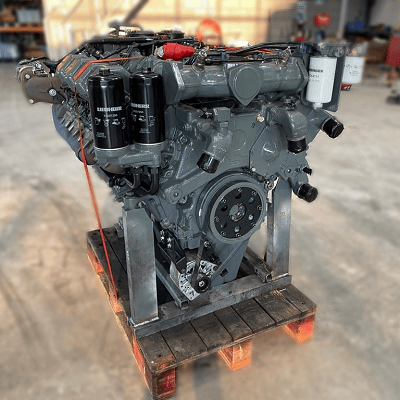The process of a dyno test on a Liebherr engine

When it comes to heavy machinery, reliability and power are paramount. Liebherr, a name synonymous with innovation and excellence in engineering, stands tall as a pioneer in the realm of heavy equipment and machinery. From towering cranes to robust excavators, Liebherr’s engineering prowess extends to the heart of these machines. We delve into the world of dyno testing a Liebherr engine, uncovering the meticulous process behind unleashing the raw power concealed within.
The foundation of excellence
Before we embark on the journey of dyno testing, it’s crucial to understand the foundation upon which Liebherr engines are built. With decades of engineering expertise and commitment to quality, Liebherr engines are crafted to withstand the most demanding environment and deliver unparalleled performance. Each component is meticulously designed and rigorously tested to ensure reliability, efficiency and longevity.
The process
1 Preparation: The engine undergoes meticulous preparation before being mounted onto the dynamo meter. This includes ensuring all connections are secure, fluids are filled to the appropriate levels, and sensors are properly calibrated.
2 Mounting: The engine is carefully mounted onto the dynamometer, a specialized device designed to simulate real-world operating conditions. Precision is paramount during this step to ensure accurate results.
3 Initial checks: Once mounted, a series of initial checks are conducted to verify proper alignment, connection integrity, and functionality of all engine systems.
4 Warm-up: The engine is started and allowed to warm up to operating temperature. This ensures consistent results and minimizes the risk of damage during testing.
5 Baseline testing: With the engine warmed up , baseline tests are conducted to establish initial performance metrics. This includes measuring power output, torque, fuel consumption, and emissions at various RPM levels.
6 Load testing: The engine is subjected to progressively increasing loads to simulate different operating conditions, such as idle, partial load and full load. This allows engineers to assess performance across the entire operating range and identify any potential issues or optimization.
7 Data analysis: Throughout the testing process, data is continuously collected and analyzed in real-time. Advanced instrumentation and software are used to monitor performance metrics and identify trends or anomalies.
8 Optimazation: Based on the data analysis, adjustments may be made to optimize engine performance. This could involve fine-tuning fuel injection timing, adjusting air-fuel ratios, or optimize turbocharger boost pressure.
9 Validation: Once testing is complete, the results are meticulously reviewed and validated against predetermined criteria and specifications. Any deviations or anomalies are thoroughly investigated to ensure accuracy and reliability.
10 Reporting: Finally, a comprehensive report is generated detailing the results of the dyno testing, including performance metrics, observations, and any recommendations for further optimization or refinement.
The outcome of dyno testing
Dyno testing a Liebherr engine is more than just a routine procedure – it’s a testament to the unwavering commitment to excellence that defines Liebherr’s engineering philosophy. By subjecting their engines to rigorous testing and analysis, Liebherr ensures that each engine delivers the uncompromising performance, reliability, and efficiency that customers expect.
In conclusion, dyno testing a Liebherr engine is not just about measuring power output. It’s about unlocking the true potential of these remarkable engines and ensuring they exceed expectations in the most challenging environments imaginable.
In the construction project, the large water mouth mold plays a crucial role. As a kind of support structure, the large water mouth mold has significant significance in ensuring the safety and stability of the project and improving the construction efficiency. This paper will introduce the related problems of large water mouth mold frame in detail to help readers better understand its application in construction engineering.
Large water mouth mold erection originated in the early 20th century, with the rapid development of the construction industry, its application gradually popularized. The large water frame is mainly used in the construction of large structures such as Bridges, high-rise buildings, factories, etc., to provide reliable support for reinforced concrete structures. The mold frame is composed of steel members and support system, which has high bearing capacity and stability.
In the construction project, the application scenarios of large water mouth mold are wide. For example, in bridge construction, the large water mouth mold can provide reliable support for the pier, beam plate and other parts of the bridge; In the construction of high-rise buildings, the large water frame can be used for cast-in-place floor slab and prefabrication of wall and column. In the construction of the plant, the large water mouth mold can be used to support the large-span beam, column and other parts.
The advantages of large water mouth die frame mainly include: improve construction efficiency, reduce labor intensity, save materials, shorten the construction period and so on. At the same time, there are also some shortcomings, such as high one-time investment costs, the need for professional design and installation teams. In view of these problems, the construction unit should fully consider the needs of the project and its own conditions, weigh the advantages and disadvantages, and choose the appropriate large water mouth mold scheme.
Large nozzle mould base,chinaplasonline,xdlmp
Shuaigang Mould Base (Yixing) Co., Ltd , https://www.shmouldbase.com